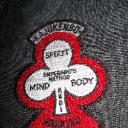Yahoo Answers is shutting down on May 4th, 2021 (Eastern Time) and the Yahoo Answers website is now in read-only mode. There will be no changes to other Yahoo properties or services, or your Yahoo account. You can find more information about the Yahoo Answers shutdown and how to download your data on this help page.
Trending News
Question for senior martial artist?
This thought came to me a week or so ago.. I realize no one has taught me this. I don't know if there is a rule for this.
What side should you wear the bars on your black belt?
I'm not sure there is a rule for this. The Okinawan and Japanese are sticklers for many things. It may be possible there is a rule for wearing your bars.
I care. That's is why I asked. If you don't know you ask. I have never heard of a tradition and was curious. It is not about me wearing a belt. I am just as comfortable wearing a white belt as any other color belt. But considering the culture and their standards I though it could be possible that there was a tradition on which side the bars are if you have them.
If I don't know the answer I will say I don't know. Other than that I won't respond.
Why does a marine, army, or navy personnel dress they way that they dress? Why d they salute the way that they salute? Why do armed forces in different countries march differently than other countries?
It is all tradition, but none of those things take away from the fundamentals of combat.
In many traditional many traditional martial arts we were a certain uniform as a tradition. We sit a certain way, We use a portion of the language of origin; all tradition. None of those things discard the need to learn or teach self defense.
In our public school we teach about the events the led up to WWI or WWII. Why is that a tradition. Most students would say that it is pointless. It doesn't concern me that was many years ago. Who cares those guys are dead. But the idea is that we study history to prevent us from repeating it. It as decided that wars were bad for all those involved. Treaties were agreed upon to prevent it from ever happening again. But even armed with the knowledge we ha
13 Answers
- Anonymous8 years agoFavorite Answer
The wearing of rank bars on the belt is not traditional at all nor is often seen in Okinawa or Japan. Although I have ranked to Nanadan in Okinawa I do not wear any bars on my belt. The fact that it is faded, torn and white with black on it speaks more than any bars ever could. I suggest you don't wear any as no one really pays attention to those in the real Karate world.
- ?Lv 68 years ago
I have restate what a couple of others have already said. Okinawans don't typically wear the stripes on their belts, that is a western affectation. Now going by what little I do know of Okinawans, I would say that IF they were going to wear the stripes and in the West the General rule of thumb is stripes to the right. That is also what I have been told about the brand tag on the belt if it has one. Why? the only satisfactory explanation I have heard is uniformity.
Source(s): 31 years MA - possumLv 78 years ago
I do not know about any other style, but WTF Taekwondo requires they be worn on the left-hand side.
The reason for this is competition. Now, rules seem to vary from time to time - which is odd, because who wants to buy different belts for different tournaments. But, originally, the bars and name were on the left, and the school name is on the right. (You didn't ask, but also the name of the country you represent is on the back of the dobok top, toward the bottom below the belt. No patches, except American (or whatever your country you represent) and Korean flags, are permitted. No other insignia is allowed). In fact, only the Adidas uniform is allowed, officially. That means, only a specific style (V-neck, not cross-over), and a certain cloth is permitted. But this is a detail between Adidas and WTF, all you have to do is wear Adidas and you should be covered. If my recollection is right, instructors, coaches, referees, and judges (ie, non-competitors) do NOT wear the bars. I believe the reason for this has to do with preventing belt bullying between officials (eg, "you're only a 4th dan, but I'm 5th dan, so what I say goes", and the like). And no matter what the belt rankings are, competitors NEVER have more say than ANY official. So theoretically, a 9th dan would have to abide by a 5th dan's commands or ruling (and 5th is the lowest rank you can be for an official), and there are avenues for contesting a ruling, and the details of this are out of scope for your question.
But, most WTF competitions don't get to this level of detail - only when officially sanctioned for regional, national, international, or Olympic events. http://www.wtf.org/ used to have a document (a coach's compendium with rule interpretations) that specified the uniform requirements. But neither WTF nor Kukkiwon post rules about this, they only say that the rules for uniform are separately published, which apparently means, before each individual competition.
I am now seeing ITF schools starting to do this. I don't know the ruling on this, I'm guessing it's instructor's perogative.
In Hwarangdo, I see rank denoted by mosquito wings worn on their sleeves (so, a 1st dan would look like a private, and 2nd dan would look like a corporal, 3rd, a sergeant; but it goes on for 4th and above). But their belts are just plain black. I don't know the details here, maybe a Hwarangdo-in can tell you more about this.
- Anonymous5 years ago
I'll try to add some more that have no been said yet, but are common mistakes nonetheless: 1) Tense while doing any movements (impede acceleration) 2) Trying to strike (legs or arms, include hand techniques) with strength instead with acceleration (relax and then explosion) 3) Strike with the wrong part of the body (side kick with flat foot instead of blade of the foot for instance) 4) Doing patterns too fast with no focus 5) Stamping with the foot while doing a hand technique (power is dispersed on the ground instead on the target) 6) Side kick looks like a mix of turning kick and side kick 7) Practicing martial arts for the wrong reasons
- SiFu frankLv 68 years ago
Our tradition at our school for 16 years has been bars on the left. Our black belt has characters on them above the bars on the right side is our name. This tradition was used in my Masters school which was run by a native Korean when he trained there in the 1980's. So I guess it wouldn't offend us.
Best to ask an Okinawan.
- kajukatLv 58 years ago
My original instructor told me that Sijo Emperado told him that bars are not allowed in black belts because other martial arts do use bars on black belts and Sijo Emperado wanted Kajukenbo to be different. Sijo Emperado also decreed that no one wash, put bleach on their belt or slash their belt with a razor blade.
My original instructor never added bars to his belt no matter how many promotions he received. He is now high ranked in Kajukenbo and he wears that appropriate color belt that goes with his rank.
When I returned to training about 5 years ago, I noticed that Kajukenbo Black Belts do wear bars on their belts. While Sijo Emperado was a great martial artist who created innovative training concepts, he was not very strict in enforcing his policies.
At least I have never seen any Kajukenbo Black Belts wearing belts that look like they were bleached or slashed with razor blades. All the belts I have seen are in pristine condition.
My current instructor wears bars on his belt, but more variations in protocol are tolerated in Kajukenbo now.
Source(s): Kajukenbo - BenjaminLv 48 years ago
Prior to the twentieth century there were only white, black or red belts in most japanese systems. The color belts were swimming designations for japanese swimmers. Traditionally you were a white belt, as in student(kyu) until you became a teacher where you rated to wear a black belt. There were no stripes on the belts at that time and the head of the system or grandmaster typically wore a special red belt. In the mid twentieth century the Kenpo system had color belts to break down the kyu ranks which evolved by Ed Parker, but the original Yoshida Clan system only had white or black belt.
Source(s): Practitioner Kenpo Jiu Jitsu - CheetahLv 68 years ago
Well, I'm not going to say that I'm right, I'll just tell you what I've been taught from two different schools. Normally, the school name is on one side with your name in the language of that art with the bars on the other side.
I've been taught that the school name goes to your left so students can read the name of the school you're from, therefore the bars go on your right.
Like I said, not sure if I'm right or not, just what I've been taught.
- ?Lv 58 years ago
I typically do my left but I don't think its a written rule. I suppose it could very from place to place though but I've never heard of any place with a rule like that.
- 7 years ago
I just came across this thread. It's imaginative however I'll throw in my two pennies.
Bars are a distinctly Okinawan tradition.
- One bar is Renshi
- Two bars is Kyoshi
- Three bars is Hanshi.
I've argued this point with others in the past and they too agreed. Just because you see someone else do it doesn't mean it is correct.
Next; the source of the belt system came from Jigoro Kano and the Kodokan [Judo]. The Butokukai [DNBK] adopted the belt system as well as a modified Gi [Do Gi] suitable to Karatedo in 1936.
When tying your belt, be sure the name of your school is on the same side of your Mon [which is the left, the same side as your patch] and your personal name is on the right [unless your school is Nagamine Shoshin then it is opposite]. The side with you name should also have the label.
Source(s): http://www.gojuryu.net/articles.php?article_id=44 Okinawa Shorin Ryu - http://www.okinawan-shorinryu.com/graphics/father-...






